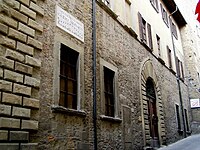Browse in the Library:
Or browse in the categories menus & download the Library Catalog PDF:
Guido d’Arezzo
(b. c. 990, Arezzo? [Italy]—d. 1050, Avellana?)
Guido d’Arezzo was a medieval music theorist whose
principles served as a foundation for modern Western
musical notation.
Educated at the Benedictine abbey at Pomposa, Guido
evidently made use of the music treatise of Odo of Saint-
Maur-des-Fossés and apparently developed his principles
of staff notation there. He left Pomposa in about 1025
because his fellow monks resisted his musical innovations,
and he was appointed by Theobald, bishop of Arezzo, as a
teacher in the cathedral school and commissioned to write
the Micrologus de disciplina artis musicae . The bishop also
arranged for Guido to give (c. 1028) to Pope John XIX an
antiphonary he had begun in Pomposa.
Guido seems to have gone to the Camaldolese monastery
at Avellana in 1029, and his fame developed from
there. Many of the 11th-century manuscripts notated in
the new manner came from Camaldolese houses.
The fundamentals of the new method consisted in
the construction by thirds of a system of four lines, or
staff, and the use of letters as clefs. The red F-line and the
yellow C-line were already in use, but Guido added a black
line between the F and the C and another black line above
the C.

The neumes could now be placed on the lines and
spaces between and a definite pitch relationship established.
No longer was it necessary to learn melodies by
rote, and Guido declared that his system reduced the 10
years normally required to become an ecclesiastical singer
to a year.
Guido was also developing his technique of solmization,
described in his Epistola de ignoto cantu . There is no evidence
that the Guidonian hand, a mnemonic device associated with his name and widely used in the Middle Ages, had any connection with Guido d’Arezzo.
Guido is also credited with the composition of a hymn
to St. John the Baptist, Ut queant laxis, in which the first
syllable of each line falls on a different tone of the hexachord
(the first six tones of the major scale); these syllables,
ut, re, mi, fa, sol, and la, are used in Latin countries as the
names of the notes from c to a (ut was eventually replaced
by do). His device was of immense practical value in teaching
sight-reading of music and in learning melodies. Singers
associated the syllables with certain intervals; mi to fa, in
particular, always represented a half step.
Before Guido an alphabetical notation using the letters
from a to p was used in France as early as 996. Guido’s system
used a series of capital letters, small letters, and double
small letters from a to g. Guido’s system also came to be
associated with the teaching of the gamut—the whole hexachord
range (the range of notes available to the singer).
In addition to his innovations Guido also described a
variety of organum (adding to a plainchant melody a second
voice singing different pitches) that moved largely, but not
completely, in parallel fourths. Guido’s work is known
through his treatise the Micrologus.
Guido D’Arezzo Music
Legacy


Guido of Arezzo’s house with plaque at Via Andrea Cesalpino, 47
A monument to him was erected in his native Arezzo. He is one of the famous Tuscans honored by a statue in the Loggiato of the Uffizi in Florence.
The computer music notation system GUIDO music notation is named after him and his invention.
The “International Guido d’Arezzo Polyphonic Contest” (Concorso Polifónico Guido d’Arezzo) is named after him.
Francisco Valls‘ controversial Missa Scala Aretina took its name from Guido Aretinus’ scale.
